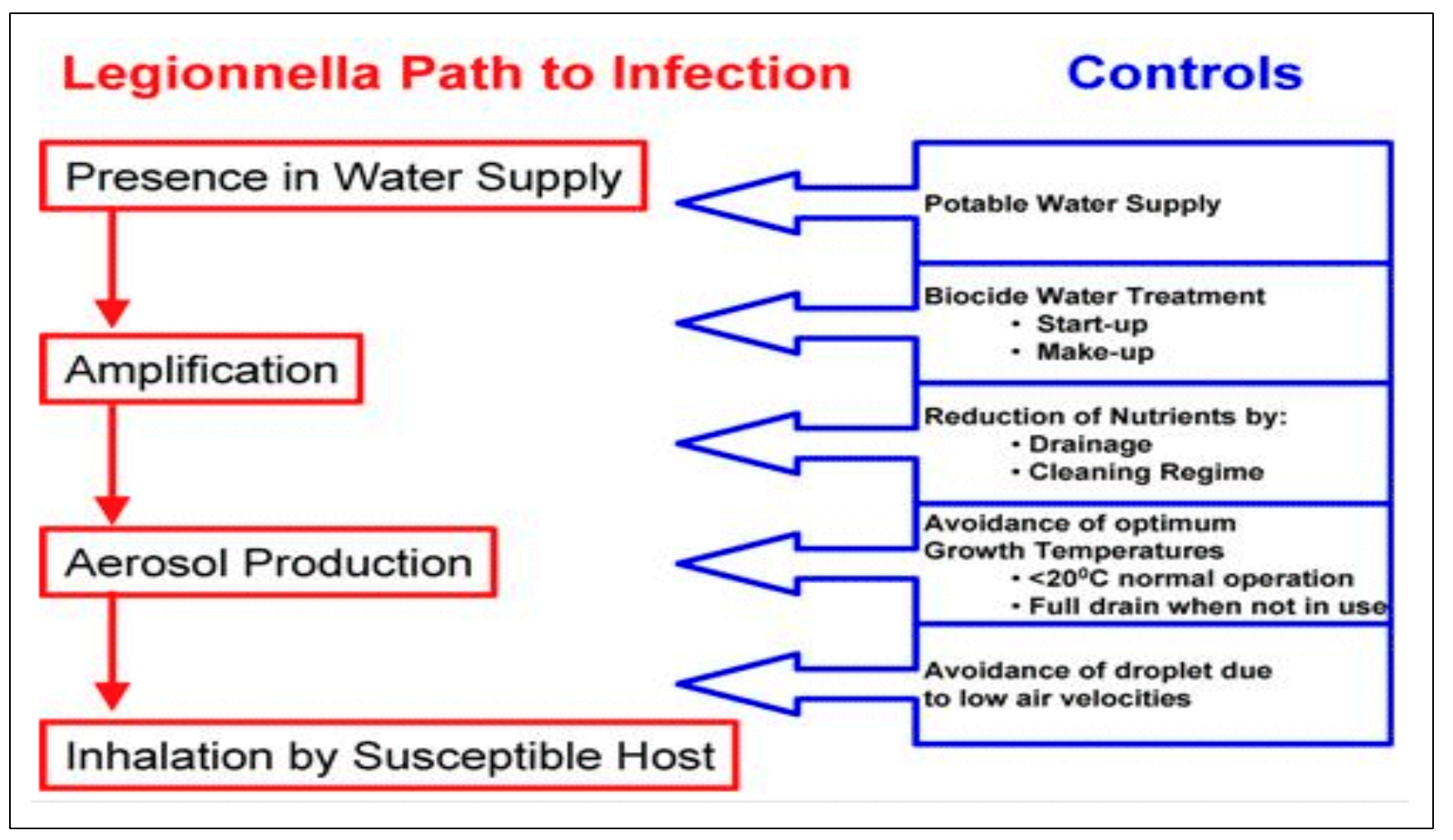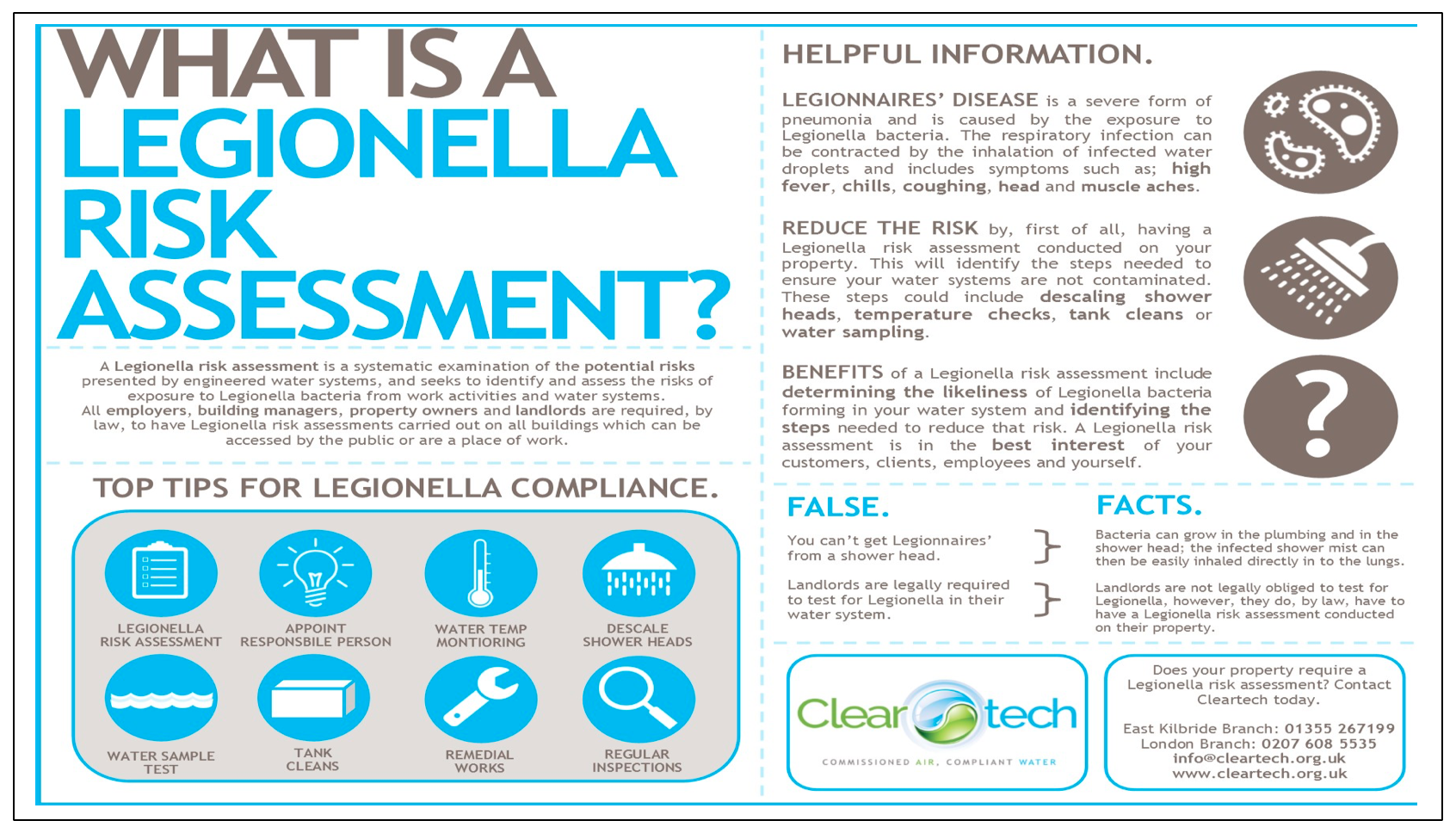 If you are an employer, or someone in control of premises, including landlords, you must understand the health risks associated with legionella. Dr. Bill Pomfret help you to recognise and control any risks.
If you are an employer, or someone in control of premises, including landlords, you must understand the health risks associated with legionella. Dr. Bill Pomfret help you to recognise and control any risks.
Duties under both Federal and Provincial laws extend to risks from legionella bacteria, which may arise from work activities. The Health and Safety at Work Regulations provide a broad framework for controlling health and safety at work.
More specifically, the Control of Substances Hazardous to Health Regulations provide a framework of actions designed to assess, prevent or control the risk from bacteria like Legionella and take suitable precautions. The Approved Code of Practice contains practical guidance on how to manage and control the risks in your system.
As an employer, or a person in control of the premises, you are responsible for health and safety and need to take the right precautions to reduce the risks of exposure to legionella. You must understand how to:
- identify and assess sources of risk
- manage any risks
- prevent or control any risks
- keep and maintain the correct records
- carry out any other duties you may have
Identify and assess sources of risk
Carrying out a risk assessment is your responsibility. You may be competent to carry out the assessment yourself but, if not, you should call on help and advice from either within your own organisation or from outside sources, e.g. consultancies.
You or the person responsible for managing risks, need to understand your water systems, the equipment associated with the system such as pumps, heat exchangers, showers etc, and its constituent parts. Identify whether they are likely to create a risk from exposure to legionella, and whether:
- the water temperature in all or some parts of the system is between 20–45 °C
- water is stored or re-circulated as part of your system
- there are sources of nutrients such as rust, sludge, scale, organic matter and biofilms
- the conditions are likely to encourage bacteria to multiply
- it is possible for water droplets to be produced and, if so, whether they can be dispersed over a wide area, e.g. showers and aerosols from cooling towers
- it is likely that any of your employees, residents, visitors etc are more susceptible to infection due to age, illness, a weakened immune system etc and whether they could be exposed to any contaminated water droplets
Your risk assessment should include:
- management responsibilities, including the name of the competent person and a description of your system
- competence and training of key personnel
- any identified potential risk sources
- any means of preventing the risk or controls in place to control risks
- monitoring, inspection and maintenance procedures
- records of the monitoring results and inspection and checks carried out
- arrangements to review the risk assessment regularly, particularly when there is reason to suspect it is no longer valid
If you conclude that there is no reasonably foreseeable risk or the risks are low and are being properly managed to comply with the law, your assessment is complete. You may not need to take any further action at this stage, but any existing controls must be maintained, and the assessment reviewed regularly in case anything changes in your system.
Managing the risk
As an employer, or person in control of premises, you must appoint someone competent to help you meet your health and safety duties and to take responsibility for controlling any identified risk from exposure to legionella bacteria. A competent person, often known as the responsible person, is someone with enough authority, competence, necessary skills, knowledge of the system, and experience. The appointed responsible person could be one, or a combination of:
- yourself
- one or more workers
- someone from outside your business
If there are several people responsible for managing risks, e.g. because of shift-work patterns, you must make sure that everyone knows what they are responsible for and how they fit into the overall risk management of the system.
If you decide to employ contractors to carry out water treatment or other work, it is still the responsibility of the competent person to ensure that the treatment is carried out to the required standards. Remember, before you employ a contractor, you should be satisfied that they can do the work you want to the standard that you require. There are several external schemes to help you with this, for example, A Code of Practice by the CSA of Ontario and an illustrated Conduct for service providers produced by the British Standards Institute have published a standard for legionella risk assessment.
Preventing or controlling the risk
You should first consider whether you can prevent the risk of legionella by looking at the type of water system you need, e.g. identify whether it is possible to replace a wet cooling tower with a dry air-cooled system. The key point is to design, maintain and operate your water services under conditions that prevent or adequately control the growth and multiplication of legionella.
If you identify a risk that you are unable to prevent, you must introduce a course of action i.e. a written control scheme, that will help you to manage the risk from legionella by implementing effective control measures, by describing:
- your system, e.g. develop a schematic diagram
- who is responsible for carrying out the assessment and managing its implementation?
- the safe and correct operation of your system
- what control methods and other precautions you will be using
- what checks will be carried out, and how often will they be carried out, to ensure the controls remain effective
You should:
- ensure that the release of water spray is properly controlled
- avoid water temperatures and conditions that favour the growth of legionella and other micro-organisms
- ensure water cannot stagnate anywhere in the system by keeping pipe lengths as short as possible or removing redundant pipework
- avoid materials that encourage the growth of legionella (The Water Fittings & Materials Directory references fittings, materials, and appliances approved for use on the Water Supply System.
- keep the system and the water in it clean
- treat water to either control the growth of legionella (and other microorganisms) or limit their ability to grow
- monitor any control measures applied
- keep records of these and other actions taken, such as maintenance or repair work
Keeping records
If you have five or more employees you have to record any significant findings, including those identified as being particularly at risk and the steps taken to prevent or control risks. If you have less than five employees, you do not need to write anything down, although it is useful to keep a written record of what you have done.
Records should include details of the:
- person or persons responsible for conducting the risk assessment, managing, and implementing the written scheme
- significant findings of the risk assessment
- written control scheme and details of its implementation
- details of the state of operation of the system, i.e. in use/not in use
- results of any monitoring inspection, test or check carried out, and the dates
These records should be retained throughout the period for which they remain current and for at least two years after that period. Records kept in accordance with (e) should be retained for at least five years.
Other duties
Under the Notification of Cooling Towers and Evaporative Condensers Regulations 1992, you must notify your local authority in writing, if you have a cooling tower or evaporative condenser on site and include details about where it is located. You must also tell them if/when such devices are no longer in use. Notification forms are available from your local authority/environmental health department.
Although less common, other systems that do not rely solely on the principle of evaporation, are dry/wet coolers or condensers. Owing to their different principles of operation, these systems may not require notification under the Notification of Cooling Towers and Evaporative Condensers Code of Practice, but it is important to assess the system against the notification requirements e.g. where such systems spray water directly onto the surface of the heat exchanger.
For further information, contact
Dr. Bill Pomfret; MSc; FIOSH; FBIM; FRSH; FBIM;
Managing Consultant, Dr. Bill Pomfret & Associates
Incorporating Safety Projects International Inc.
26, Drysdale Street, Kanata, Ontario, K2K 3L3.
www.spi5star.com pomfretb@spi5star.com
Tel: 613-2549233

